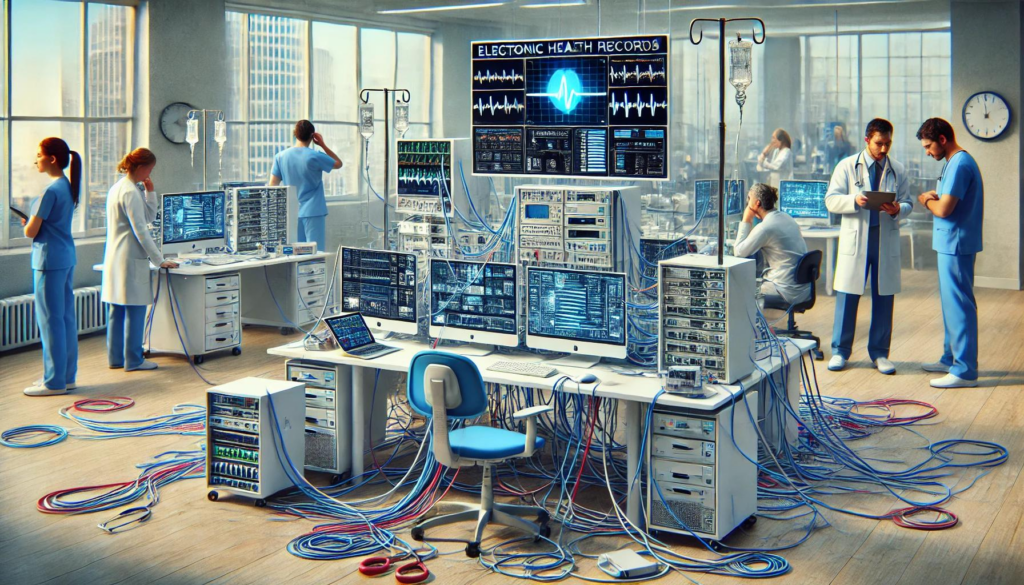Is Interoperability the Future of Healthcare?
Interoperability in Healthcare – Why is it Important?
In 2022, the global healthcare interoperability solutions market was worth an estimated $3.4 billion, and is now poised to grow at a rate of 12.9% through 2027, according to a 2023 report by MarketsandMarkets.
In recent years, we’ve seen a strong push for healthcare interoperability, driven by the need to enhance patient care and streamline operations across healthcare systems. The surge is propelled by government efforts to boost patient care via enhanced data exchange capabilities and the rising acceptance of electronic health records (EHRs).
Healthcare Interoperability Success Stories
Several healthcare organizations have successfully implemented interoperability solutions, leading to improved patient outcomes and operational efficiencies. Case studies show how interoperability has significantly enhanced healthcare delivery by enabling cross-platform health data sharing and streamlined patient data integration in the cloud, specifically around genomics.
As healthcare professionals strive to provide the highest quality of care, the ability to access, share, and utilize patient information across various systems and platforms becomes indispensable. By enabling diverse health IT systems to communicate effortlessly, interoperability paves the way for a more coordinated, efficient, and patient-centric healthcare environment. In this blog, we explore the concept of interoperability and why it seems so difficult to achieve in healthcare. Interoperability in Healthcare not only supports better clinical decision-making but also enhances operational efficiencies and promotes comprehensive care continuity.
Interoperability in Healthcare – Why is it So Difficult to Achieve?
Interoperability in healthcare refers to the ability of different information systems, devices, and applications to access, exchange, integrate, and cooperatively use data in a coordinated manner. This ensures that information is easily available to the right people at the right time to improve health outcomes for patients. Given the rising complexity of healthcare needs and advancements in technology, achieving seamless interoperability is becoming increasingly critical.
As healthcare organizations invest in advanced interoperability solutions, several key trends are emerging. These include the adoption of cloud-based platforms for data storage and exchange, the implementation of standardized data formats to facilitate smoother integration, and the use of artificial intelligence and machine learning to analyze and interpret complex health data. Furthermore, initiatives like the Fast Healthcare Interoperability Resources (FHIR) standard are playing a pivotal role in defining how healthcare information can be exchanged between systems, thereby promoting greater efficiency and collaboration.

Key Technology Trends in Healthcare Interoperability Can Include:
-
- Adoption of cloud-based platforms for data storage and exchange
-
- The Implementation of standardized data formats to facilitate smoother integration
-
- The use of artificial intelligence and machine learning to analyze and interpret complex health data
With these trends, the future of healthcare interoperability looks promising, offering the potential to revolutionize patient care by ensuring that crucial health information is readily available and actionable across the entire continuum of care.
Healthcare Interoperability Challenges
Interoperability, while technically achievable for many providers, continues to present challenges due to technological, organizational, and environmental factors. Ultimately, research indicates that integrating the end user perspective into the development, implementation, policy-making, and standardization of health information technology could enhance progress in achieving interoperability. Let’s dive into some of the challenges and opportunities of healthcare interoperability.
Fragmented Healthcare Systems
One of the primary challenges in the healthcare industry is the fragmentation of healthcare systems. Different hospitals and clinics often use various electronic health records (EHR) systems that aren’t designed to work together, leading to silos of patient information. This lack of interoperability can severely hinder the ability to provide coordinated and high-quality care to patients.
According to a report by the Office of the National Coordinator for Health Information Technology (ONC), only 26% of hospitals reported having the capability to electronically find, send, receive, and integrate patient health information from outside sources in 2017. This fragmentation not only creates inefficiencies but also increases the risk of medical errors, duplicative testing, and gaps in care.
The inability of different EHR systems to communicate seamlessly means that vital patient information can be lost or inaccessible at critical times, thereby compromising patient safety and care quality. As healthcare technologies continue to evolve, addressing these interoperability challenges remains crucial for achieving a more integrated and effective healthcare system. (Source: Office of the National Coordinator for Health Information Technology, 2017).
Lack of Standardization
The absence of universal interoperability standards in healthcare further complicates data sharing. For example, one hospital may use the HL7 standard for electronic health records (EHRs), while another uses the FHIR standard. Without common standards, exchanging data between these disparate systems becomes cumbersome and error-prone (Smith, J., & Watson, R., 2020, “Healthcare Interoperability Challenges,” Journal of Medical Informatics).
Growing Number of Healthcare Applications
The diverse nature of healthcare applications can often result in data silos, where crucial patient information is trapped within specific software or platforms, impeding seamless sharing and exchange of data. Additionally, the varying levels of technological sophistication among healthcare organizations can further complicate interoperability efforts. While some institutions may have advanced systems capable of data integration, others may still rely on outdated infrastructure that hinders smooth data flow.
Specifically, many community health centers operate on a lot of different EHR platforms that do not communicate or integrate well with one another.
Data Privacy and Security Concerns
Healthcare data is highly sensitive, and ensuring its privacy and security during exchange poses significant challenges. Cybersecurity threats and regulatory requirements, such as HIPAA, add layers of complexity to implementing effective interoperability solutions.
Technological Barriers to Healthcare Interoperability
Technological limitations can also impede interoperability. Legacy systems, inadequate IT infrastructure, and insufficient technical expertise within healthcare organizations can hinder the integration of modern interoperability solutions. According to a study published in the Journal of the American Medical Informatics Association (JAMIA) in 2021, outdated legacy systems often lack the capability to communicate effectively with newer systems, creating silos of information that are difficult to bridge (JAMIA, 2021). Additionally, a report by Deloitte in 2022 highlighted that many healthcare organizations struggle with inadequate IT infrastructure, which can result in data bottlenecks and slow transfer rates, further complicating interoperability efforts (Deloitte, 2022). Finally, a HIMSS survey from 2020 found that many healthcare organizations face a shortage of skilled IT professionals, which limits their ability to implement and maintain advanced interoperability solutions effectively (HIMSS, 2020). These technological barriers collectively impede the seamless exchange of health information, impacting patient care and operational efficiency.

Opportunities for Improvement
Cloud-Based Solutions
Cloud services for health data sharing offer scalable, flexible, and cost-effective platforms for interoperability. EHR interoperability cloud solutions enable real-time data access and sharing, improving efficiency and patient care.
Cloud-based solutions have significantly mitigated the negative impact of interoperability issues in healthcare. By providing a centralized and standardized platform for data exchange, these solutions ensure seamless communication between different healthcare systems. This leads to reduced administrative burdens, decreased likelihood of errors, and enhanced patient outcomes. For instance, a study published in the Journal of Medical Internet Research highlights how cloud computing has streamlined data sharing and improved care coordination among healthcare providers.
New Population Health Software to Improve Interoperability
The integration of new population health software offers significant opportunities for enhancing healthcare interoperability. By leveraging advanced data analytics and seamless information exchange, healthcare providers can achieve a more holistic view of patient health, leading to improved care coordination and outcomes. For instance, a study by the Office of the National Coordinator for Health Information Technology (ONC) highlights that enhanced interoperability can reduce duplicative testing and avoid medication errors, thereby increasing efficiency and patient safety (ONC, 2020). Furthermore, adopting such software facilitates the management of chronic diseases by enabling real-time access to patient data across different care settings, as noted by a report from the Healthcare Information and Management Systems Society (HIMSS, 2019). These advancements underscore the potential for population health software to bridge existing gaps in healthcare interoperability, ultimately fostering a more connected and efficient healthcare system.
Enhanced Data Exchange Mechanisms
Innovative data interoperability in healthcare IT, such as advanced APIs and blockchain technology, can facilitate secure and efficient data exchange, addressing many existing barriers. For example, a hospital using blockchain can securely share patient records with a specialist clinic, ensuring data integrity and privacy.
Collaboration and Policy Making
Increased collaboration among stakeholders, including healthcare providers, technology vendors, and regulatory bodies, can drive the development of robust interoperability frameworks. Policy support and incentives can further promote the adoption of interoperability standards in healthcare.
The Future of Healthcare Interoperability
The future of healthcare interoperability holds immense potential. With advancements in cloud computing, AI, and machine learning, we can expect more sophisticated and efficient interoperability solutions. Seamless health information exchange in the cloud will become the norm, paving the way for predictive analytics and personalized medicine.
By understanding and addressing the challenges of healthcare interoperability while leveraging emerging opportunities, healthcare organizations can significantly enhance their data exchange capabilities, ultimately leading to better patient care and outcomes.
Speak with a healthcare cloud expert today.
FAQ
What are some of the main issues with interoperability in healthcare?
Some main issues of interoperability in healthcare include:
-
- Fragmented systems
-
- Lack of standardization
-
- Data privacy
-
- Security concerns
-
- Technological barriers
Why is interoperability important in healthcare?
Interoperability in healthcare is crucial because it allows seamless data exchange, improves patient care, enhances operational efficiency, and enables better decision-making by healthcare providers.
Why are healthcare organizations concerned with interoperability?
Healthcare organizations are concerned because interoperability directly impacts patient safety, care quality, regulatory compliance, and operational costs.
How can companies take steps toward achieving interoperability in healthcare?
Companies can adopt established standards like FHIR, invest in cloud-based interoperability solutions, enhance data exchange mechanisms, and collaborate with stakeholders to develop comprehensive interoperability frameworks.
How does HL7 support interoperability in healthcare?
HL7 supports interoperability in healthcare by providing a standardized framework that enables different healthcare systems, applications, and devices to exchange patient information consistently and accurately. Through its messaging standards, HL7 facilitates the seamless sharing of health data across various platforms. This means that patient information, such as lab results, medication records, and treatment histories, can be securely transmitted and understood by different systems, regardless of technology.
Unlock the power of a Healthcare Security and Compliance Expert Today.



